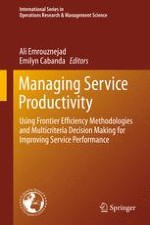2014 | OriginalPaper | Buchkapitel
Service Productivity in IT: A Network Efficiency Measure with Application to Communication Systems
verfasst von : Adeyemi Abel Ajibesin, Neco Ventura, H. Anthony Chan, Alexandru Murgu
Erschienen in: Managing Service Productivity
Verlag: Springer Berlin Heidelberg
Aktivieren Sie unsere intelligente Suche, um passende Fachinhalte oder Patente zu finden.
Wählen Sie Textabschnitte aus um mit Künstlicher Intelligenz passenden Patente zu finden. powered by
Markieren Sie Textabschnitte, um KI-gestützt weitere passende Inhalte zu finden. powered by
